St Johns Riverside Community Garden – down by the riverside
In August 2019, Judy Vizzari visited St Johns Riverside Community Garden in Heidelberg.
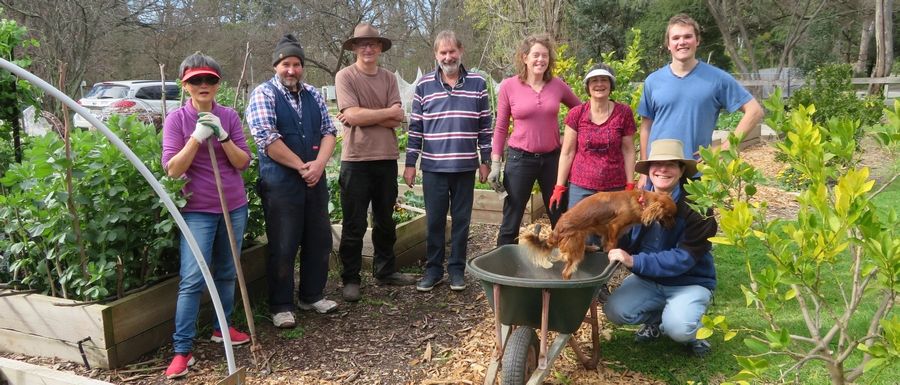 Walkers and cyclists will know a section of the Yarra Trail near Heidelberg which is called Banyule Flats – a stretch of land comprising open grassland, bushland and swampy waterways. It’s a rich and beautiful place.
Walkers and cyclists will know a section of the Yarra Trail near Heidelberg which is called Banyule Flats – a stretch of land comprising open grassland, bushland and swampy waterways. It’s a rich and beautiful place.
St John’s Anglican Church sits on an embankment high above the Flats and just short of the township of Heidelberg. You can find it either by passing through the town to Burgundy Street or at the junction of the tennis courts, Salt Creek and the main Yarra Trail. The church is impressive; Gothic construction, built in the 1850s.
Walkers rounding a bend in the path are confronted with a view of the church above and below it, an impressive community garden – St Johns Riverside Community Garden. This is where Guy Palmer and I have come on a still Sunday morning – Guy has visited before but I’m a newcomer. I’m here to see and learn about the garden and its community of organisers and gardeners.
 I arrive first and am met in the church carpark by Katrina Philip, the garden’s coordinator. She’s bright-eyed and enthusiastic and leads me through the hilltop bushes and trees, past a collection of beehives then down the steep slope to the garden below. These hives, Katrina tells me, are shared between the community garden and an active local apiarists’ club, The Beekeepers Club Inc, which supports beekeepers and beekeeping throughout the Eastern suburbs of Melbourne with training courses, information sharing and mentoring.
I arrive first and am met in the church carpark by Katrina Philip, the garden’s coordinator. She’s bright-eyed and enthusiastic and leads me through the hilltop bushes and trees, past a collection of beehives then down the steep slope to the garden below. These hives, Katrina tells me, are shared between the community garden and an active local apiarists’ club, The Beekeepers Club Inc, which supports beekeepers and beekeeping throughout the Eastern suburbs of Melbourne with training courses, information sharing and mentoring.
As we walk, I learn that the garden is now in its fifth year, that members pay a small annual membership fee, and that they are encouraged to contribute their time – perhaps once monthly – to working bees. Workshops are conducted for members and the general public. This garden is a communal affair which relies on the  enthusiasm and goodwill of its members. It seems that sharing is an important component of this space.
enthusiasm and goodwill of its members. It seems that sharing is an important component of this space.
Before descending, I look down onto several rows of flourishing garden plots and wicking beds running parallel to the river. Beyond them is an orchard and, to the left, is a series of four entoucas tennis courts. The closest court is obviously utilised by the gardeners as it houses a propagating shelter, a row of baths converted to wicking beds, and some impressive black boxes. It’s partly these boxes, called ‘FoodCubes’, that we’ve come to see but first I want to hear how the garden works so Katrina introduces me to Brian Koop.
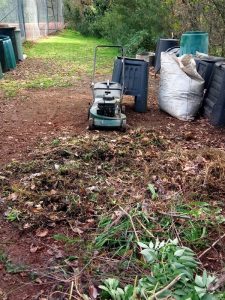 Brian’s compost machine
Brian’s compost machine
Brian is the man whose role it is to assist with augmenting the soil and growing the crops and he, assisted by his willing team, appear to be very successful.
We’re standing in his domain – a section roughly ten metres long and four metres wide squeezed in between the converted tennis court and the Yarra Trail and filled with compost containers, worm farms, stacked hay and, spread out on the ground, a variety of green garden cuttings. This is an organised work space.
A visitor has just arrived with a black bin containing a mix of kitchen fruit and vegetable scraps. Its contents are added to a larger compost caddy labelled “We Want Compost Not Landfill“. This, Brian tells me, is a collection point for the plot owners and locals to donate green waste and  compostable material which is then sorted before being added to his ‘compost machine’. The visitor is one of a number of ‘off the street’ contributors who park close by and bring full bins a short distance via the trail to the drop-off point.
compostable material which is then sorted before being added to his ‘compost machine’. The visitor is one of a number of ‘off the street’ contributors who park close by and bring full bins a short distance via the trail to the drop-off point.
Brian explains that the visitor is part of the the ShareWaste scheme, which helps connect those who wish to donate food scraps with those who wish to receive them for composting purposes. He appreciates all participants in the scheme which, he says, works well and provides a valuable source of compostable material for the community garden.
Next to the collection point are three open compost boxes constructed of heavy timber by Paul Gale-Baker, a man well-known in 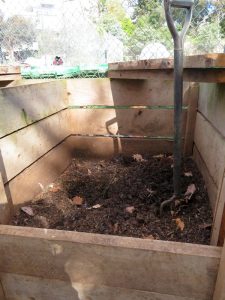 gardening circles, especially for his association with Macleod Organic Community Garden. The bins are roughly a metre square and are easily dissembled to enable easy transfer of compost materials.
gardening circles, especially for his association with Macleod Organic Community Garden. The bins are roughly a metre square and are easily dissembled to enable easy transfer of compost materials.
Brian employs a ‘hot compost’ system which, he says, works best when all of the organic ingredients are chopped or shredded as much as possible. As well as ShareWaste ingredients, he incorporates garden waste such as grass clippings, oak leaves, animal manures and garden trimmings, which are all piled next to the compost bays then mowed to break them into small pieces. This chopping process is effective but rather tedious – with so much material, how useful a mulching machine would be!
The ingredients are placed into one of the composting bays and, given appropriate moisture and oxygen, the pile heats quickly to temperatures around 50°C. The mix starts to cook and to decompose and then, every three to seven days, it is forked into the adjacent empty bay to further break down and to re-introduce oxygen and moisture, thus re-starting the cooking process. Over the next few weeks, the pile is turned up to five times, until eventually it cools. By this stage, earthworms appear in its moist areas and indicate that it’s ready for the garden.
With so many plots to replenish, soil production is an important and constant activity in this communal space and Brian is pleased to see locals, as well as members, contributing to his system.
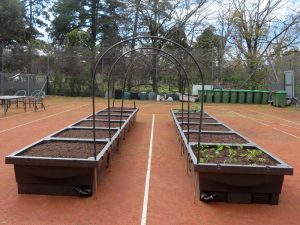 Fancy ‘FoodCubes’
Fancy ‘FoodCubes’
On the tennis court are two rows of curious black bins which Brian tells me have been purchased with a Banyule Council Environment grant. He’s excited about these recently installed bins and the plot owners seem equally excited about an opportunity to test them out – first in first served …
The bins are called FoodCubes and there are 12 of them in total, each a metre square, connected by a pipe which extends the full length of the row and maintains a level of water in the reservoirs in each base. On top of each base is a moulded upper container with four hollow legs. The upper bins are filled with  potting soil which is also packed into the hollow legs extending down into the reservoir below to enable water to be drawn upwards as required by growing plants. This system provides a constant water source adjusted by a single overflow valve serving all bins. Curved rods are placed into slots to support shade cloth or netting which will prevent insects and animals from ravaging crops.
potting soil which is also packed into the hollow legs extending down into the reservoir below to enable water to be drawn upwards as required by growing plants. This system provides a constant water source adjusted by a single overflow valve serving all bins. Curved rods are placed into slots to support shade cloth or netting which will prevent insects and animals from ravaging crops.
Brian tells me that to fill these cubes will require more soil than he can manufacture, but he has found a valuable source of compost to augment the garden’s production – Banyule Council supply compost manufactured from collected residents’ green waste for local initiatives. On his request, they supplied eight cubic metres to the garden – a handsome addition to their 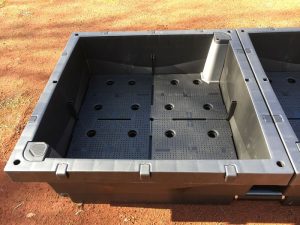 resources.
resources.
The cubes, built by Biofilta in Seaford, appear to be innovative, economical and particularly appropriate to large area applications. It will be interesting to hear how they perform.
And the rest of the garden?
Whilst I have been talking with Brian, Guy has been with the other gardeners as they tend their plots and chat. I too, wander between the established wicking beds and original ground level plots and am  impressed by the volume of massed, flowering peas, mixed lettuces, broccoli, in season flowers and range of exotic vegetables. The orchard is small and the trees still dormant, but there’s variety in the two rows which will soon present a colourful welcome to visitors.
impressed by the volume of massed, flowering peas, mixed lettuces, broccoli, in season flowers and range of exotic vegetables. The orchard is small and the trees still dormant, but there’s variety in the two rows which will soon present a colourful welcome to visitors.
Artwork makes a statement
There’s another feature of this place which enhances its worth – its artwork. I see local artist Pamela Griffiths’ colourful mosaics on many of the wicking beds and a huge wire ‘compost teapot’ centre stage – this isn’t a vehicle for ‘hot’ compost but as it contains oak leaves, it’s brewing! I’m intrigued – the teapot, which was purchased with the support of the Bendigo Bank Community Grants scheme, provides a delightful and slightly humorous focus in the 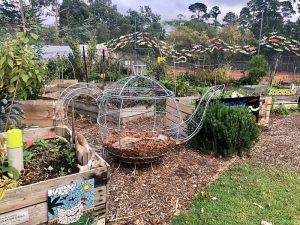 garden.
garden.
On the wire wall of the tennis court is a mural which was created during Banyule’s annual Kids ArtyFarty Festival with financial support from the Banyule Council. It depicts a series of fish, eels and platypus colourfully fashioned in clay by children then fired and attached to the wire to represent the abundance of the Yarra River. Local artist Felicity Gordon worked with the children to complete their task. This mural is a striking and a lovely feature that draws families into the space and the gardeners hope that the children will return again and again not just to see their artwork but also to learn about growing food. Time has passed, morning mists have given way to bright sunshine and a table has miraculously appeared 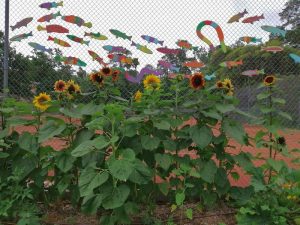 loaded with freshly baked scones, home-made quince paste and, as Enid Blyton might write, ‘lashings of cream’. There’s tea and coffee too. It’s here I meet Jon Buttery who, along with Katrina and Brian, is a third member of the garden committee and is, Katrina says, “gifted, and a support in every way – including hospitality (with scones) and connecting us with the community – bureaucracy matters become a breeze when he involves himself!”
loaded with freshly baked scones, home-made quince paste and, as Enid Blyton might write, ‘lashings of cream’. There’s tea and coffee too. It’s here I meet Jon Buttery who, along with Katrina and Brian, is a third member of the garden committee and is, Katrina says, “gifted, and a support in every way – including hospitality (with scones) and connecting us with the community – bureaucracy matters become a breeze when he involves himself!”
We share their pleasure and their morning tea and leave.
The notion of community gardening was foreign in Melbourne suburbs during my youth but now, it seems, it’s well-recognised as a great way for gardeners of all ages to grow quality food, utilise unused spaces and create venues for both space-challenged gardeners and social interactions. No wonder more and more community gardens are popping up in our suburbs – more than 60 in North East Melbourne alone.

The desired temperature for a hot compost is around 50 degrees Celsius which will occur naturally when enough moist organic matter is brought together into a pile. At 500 degrees, you would be looking at the only community garden in the world with an onsite volcano. Something to aim for.
Thanks, Brian (and everyone also who wrote in to similar effect). The typo has now been corrected.
Brian Koop were you involved with Godshouse in thev1960 and 70s my name is Michael sadlier im.from.western Australia i thiught id look up.people i met intheb70s and70s im.a friend of smilies in qld and Bechir Ishmakovich s
Hi Michael,
Brian wants to talk to you but the email address that you gave us doesn’t work. Can you give us a corrected email address?
Guy (Palmer)
Local Food Connect
Congratulations to all involved in this marvellous community garden.
I hope the new FoodCubes are productive and successful. I look forward to a review at the end of the summer!
It’s a lovely write up of the place and people.
Many thanks to Judy.
Thanks for your encouragement, Fay.
Brilliant work, StJohn’s gardeners! Tremendous progress in face of real difficulties!
You are kind!